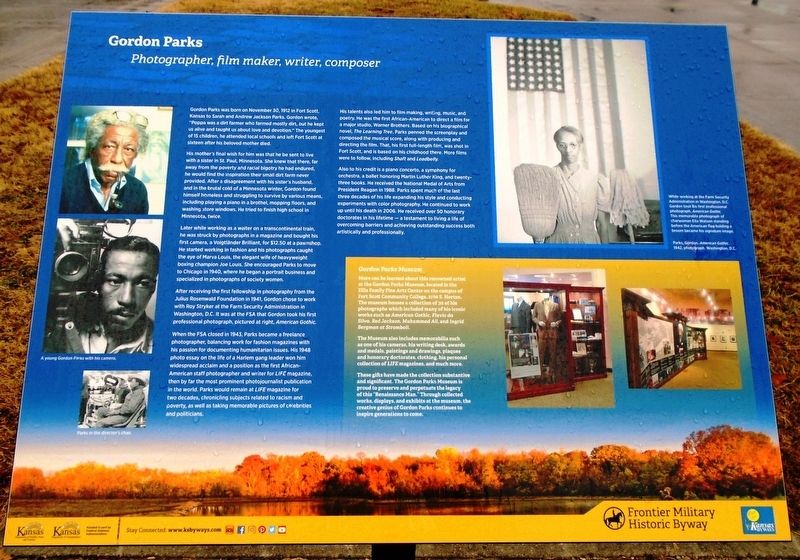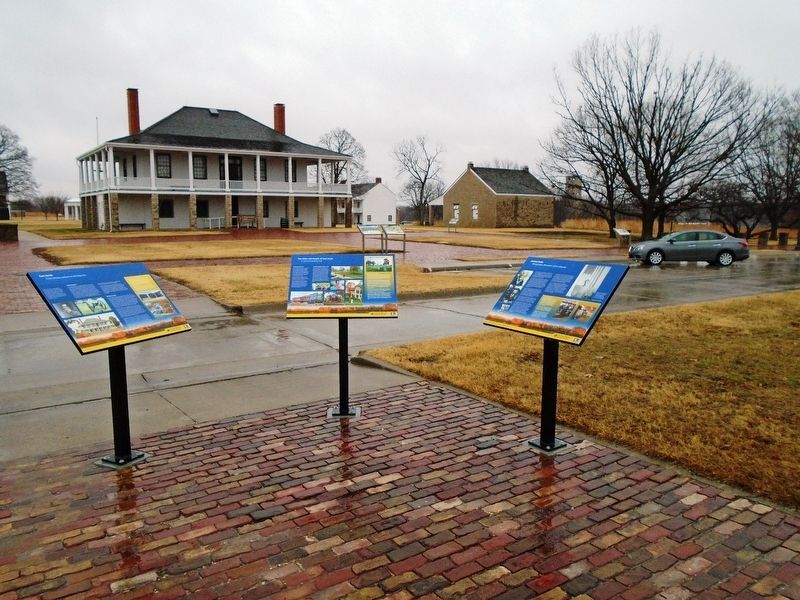Fort Scott in Bourbon County, Kansas — The American Midwest (Upper Plains)
Gordon Parks
Photographer, film maker, writer, composer
Gordon Parks was born on November 20, 1912 in Fort Scott, Kansas to Sarah and Andrew Jackson Parks. Gordon wrote, "Poppa was a dirt farmer who farmed mostly dirt, but he kept us alive and taught us about love and devotion." The youngest of 15 children, he attended local schools and left Fort Scott at sixteen after his beloved mother died.
His mother's final wish for him was that he be sent to live with a sister in St. Paul, Minnesota. She knew that there, far away from the poverty and racial bigotry he had endured, he would find the inspiration their small dirt farm never provided. After a disagreement with his sister's husband, and in the brutal cold of a Minnesota winter, Gordon found himself homeless and struggling to survive by various means, including playing a piano in a brothel, mopping floors, and washing store windows. He tried to finish high school in Minnesota, twice.
Later while working as a waiter on a transcontinental train, he was struck by photographs in a magazine and bought his first camera, a Voigtländer Brilliant, for $12.50 at a pawnshop. He started working in fashion and his photographs caught the eye of Marva Louis, the elegant wife of heavyweight boxing champion Joe Louis. She encouraged Parks to move to Chicago in 1940, where he began a portrait business and specialized in photographs of society women.
After receiving the first fellowship in photography from the Julius Rosenwald Foundation in 1941, Gordon chose to work with Roy Stryker at the Farm Security Administration in Washington, D.C. It was at the FSA that Gordon took his first professional photograph, pictured at right, American Gothic.
When the FSA closed in 1943, Parks became a freelance photographer, balancing work for fashion magazines with his passion for documenting humanitarian issues. His 1948 photo essay on the life of a Harlem gang leader won him widespread acclaim and a position as the first African-American staff photographer and writer for LIFE magazine, then by far the most prominent photojournalist publication in the world. Parks would remain at LIFE magazine for two decades, chronicling subjects related to racism and poverty, as well as taking memorable pictures of celebrities and politicians.
His talents also led him to film making, writing, music, and poetry. He was the first African-American to direct a film for a major studio, Warner Brothers. Based on his biographical novel, The Learning Tree, Parks penned the screenplay and composed the musical score, along with producing and directing the film. That, his first full-length film, was shot in Fort Scott, and is based on his childhood there. More films were to follow, including Shaft
and Leadbelly.
Also to his credit is a piano concerto, a symphony for orchestra, a ballet honoring Martin Luther King [Jr.], and twenty-three books. He received the National Medal of Arts from President Reagan in 1988. Parks spent much of the last three decades of his life expanding his style and conducting experiments with color photography. He continued to work up until his death in 2006. He received over 50 honorary doctorates in his lifetime — a testament to living a life of overcoming barriers and achieving outstanding success both artistically and professionally.
Gordon Parks Museum
More can be learned about this renowned artist at the Gordon Parks Museum, located in the Ellis Family Fine Arts Center on the campus of Fort Scott Community College, 2108 S. Horton. The museum houses a collection of 30 of his photographs which include[s] many of his iconic works such as American Gothic, Flavio da Silva, Red Jackson, Muhammad Ali, and Ingrid Bergman at Stomboli.
The Museum also includes memorabilia such as one of his cameras, his writing desk, awards and medals, paintings and drawings, plaques and honorary doctorates, clothing, his personal collection of LIFE magazines, and much more.
These gifts have made the collection substantive and significant. The Gordon Parks Museum is proud to preserve and perpetuate the legacy of this "Renaissance Man." Through collected works, displays, and exhibits at the museum, the creative genius of Gordon Parks continues to inspire generations to come.
[Photo captions, left to right, read]
• [Gordon Parks]
• A young Gordon Parks with his camera.
• Parks in the director's chair.
• While working at the Farm Security Administration in Washington, D.C. Gordon took his first professional photograph, American Gothic. This memorable photograph of charwoman Ella Watson standing before the American flag holding a broom became his signature image.
Parks, Gordon. American Gothic.
1942, photograph. Washington, D.C.
Erected by Frontier Military Historic Byway (Kansas Byways).
Topics and series. This historical marker is listed in these topic lists: African Americans • Arts, Letters, Music • Civil Rights. In addition, it is included in the Former U.S. Presidents: #40 Ronald Reagan, and the Fort Scott, Kansas series lists. A significant historical date for this entry is November 20, 1912.
Location. 37° 50.575′ N, 94° 42.347′ W. Marker is in Fort Scott, Kansas, in Bourbon County. Marker is at the intersection of Old Fort Boulevard and Main Street, in the median on Old Fort Boulevard. Marker is adjacent to Skubitz Plaza. Touch for map. Marker is in this post office area: Fort Scott KS 66701, United States of America. Touch for directions.
Other nearby markers. At least 8 other markers are within walking distance of this marker. The Sites and People of Fort Scott (here, next to this marker); Fort Scott (here, next to this marker); Fort Scott Yesterday (a few steps from this marker); Civil War Town (within shouting distance of this marker); Medal of Honor (within shouting distance of this marker); Sutler Store (within shouting distance of this marker); Star Clothing House (within shouting distance of this marker); Fort Gardens (within shouting distance of this marker). Touch for a list and map of all markers in Fort Scott.
Related markers. Click here for a list of markers that are related to this marker.
Also see . . .
1. Gordon Parks Museum. Museum website homepage (Submitted on January 17, 2019, by William Fischer, Jr. of Scranton, Pennsylvania.)
2. Gordon Parks. International Center of Photography website entry (Submitted on January 17, 2019, by William Fischer, Jr. of Scranton, Pennsylvania.)
3. The Gordon Parks Foundation. Foundation website homepage (Submitted on January 17, 2019, by William Fischer, Jr. of Scranton, Pennsylvania.)
4. Gordon Parks. Wikipedia entry (Submitted on January 17, 2019, by William Fischer, Jr. of Scranton, Pennsylvania.)
Credits. This page was last revised on November 30, 2021. It was originally submitted on January 17, 2019, by William Fischer, Jr. of Scranton, Pennsylvania. This page has been viewed 303 times since then and 20 times this year. Photos: 1, 2. submitted on January 17, 2019, by William Fischer, Jr. of Scranton, Pennsylvania.

